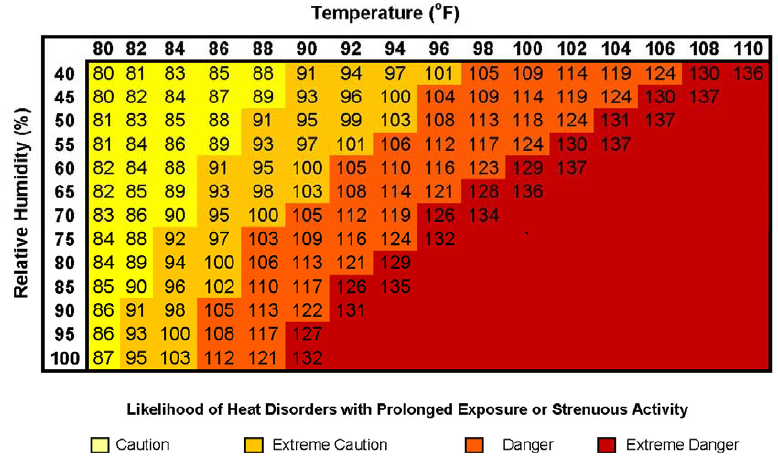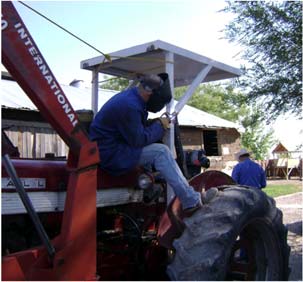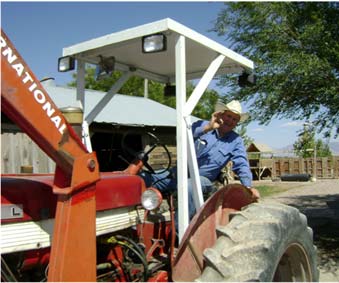Farming in the Heat with Chronic Health Conditions
Working in the sun and heat without taking precautions can be hazardous and even deadly, especially for people with certain health conditions. Heat-related illness occurs when a person’s body cannot cool itself quickly enough and the body temperature rises. Health conditions and use of some medications can also impact one’s ability to regulate body temperature, making the risk of heat exhaustion or heat stroke higher.1-3 Factors that can increase susceptibility to heat-related illness include:
- Medical Conditions – Certain medical conditions reduce the body’s ability to regulate body temperature, putting one at greater risk in hot conditions. Be particularly cautious working in the heat if you:
- have heart disease, such as arrhythmias, atrial fibrillation, or heart failure
- have lung disease, such as asthma, COPD, or lung cancer
- have diabetes
- have high blood pressure
- are obese or underweight
- are pregnant
- have a history of previous heat stroke
- currently have a sunburn or temporary respiratory illness such as pneumonia or bronchitis
In addition, Alzheimer’s disease, Parkinson’s disease, and prior stroke can interfere with the body’s ability to recognize signs of thirst, which can lead to dehydration and increased risk of heat-related illness.

- Medications – Many medications interfere with the body’s ability to cool itself. People who are taking medication should check the list of side effects before working in the heat, particularly if they are using:
- vasoconstrictors (medications that narrow blood vessels)
- beta blockers (medications that regulate blood pressure by blocking adrenaline)
- antidepressants or antipsychotics
- tranquilizers
- antihistamines
- diuretics
- stimulants (for ADHD or illegal stimulants)
- sleeping pills (including over the counter)
- Age – People over age 65 have greater difficulty regulating body temperature and are more impacted by heat. Young children heat up much more quickly than adults and should be protected and monitored in high heat conditions.
- Work Environments - Farmers and ranchers are especially susceptible to heat-related illness since much of their work takes place outdoors or in buildings without air conditioning. In addition, heat takes a greater toll when doing work that:
- requires Personal Protective Equipment
- includes exposure to certain chemicals or pesticides
- involves heavy equipment that produces heat
- occurs in areas with high humidity (Figure 2)
- introduces a hot environment quickly, without a period of gradual exposure to hot working conditions

Heat-Related Illness
Heat can impact one’s ability to work safely and effectively. Short-term heat exposure can reduce physical strength and impair judgment, which may lead to accident or injury.1 Prolonged exposure can cause heat-related illness, such as heat exhaustion or heat stroke.2,3
Heat Exhaustion occurs when the systems that regulate body temperature become overwhelmed and body temperature rises. Heat exhaustion is the result of an excessive loss of water and salt contained in sweat. As one’s body temperature rises, an affected person may experience a variety of symptoms, including:
- muscle cramps
- heavy sweating or pale skin
- dizziness, irritability, or fainting
- nausea
- fatigue
- signs of dehydration, such as extreme thirst, dry mouth, or dark-colored urine
- rapid heartbeat or breathing
Heat exhaustion can usually be treated at home by taking measures that will gradually reduce body temperature. If treatment does not provide relief within 30 minutes, professional medical attention is needed. To treat heat exhaustion:
- stop work immediately
- move to an air-conditioned or shady location, and use fans to circulate air
- remove unnecessary clothing, including shoes and socks
- drink plenty of cool liquids, such as water or sports drinks (avoid caffeine and alcohol)
- apply cool damp cloths to the skin or take a cool shower or bath
- monitor for signs of heat stroke
Heat Stroke is a life threatening condition that occurs when the internal temperature of the body reaches 104℉. Heat stroke can cause damage to your organs and brain, and may result in a heart attack, coma, or death. Signs of heat stroke are:
- red, hot, and dry skin (no sweating)
- very high body temperature
- rapid, strong pulse
- severe headache
- confusion
- seizures
- loss of consciousness
Heat stroke is a medical emergency that should be treated by a professional immediately! If heat stroke is suspected, call 911. Stay with the affected person until help arrives, and apply the following treatments for heat exhaustion:
- move the person to a cool area as quickly as possible
- remove any unnecessary clothing
- increase ventilation by opening windows or using a fan
- give the person water to drink (if he/she is conscious)
- shower the skin with cool (not cold) water, or cover the body with cool, damp towels
Preventing Heat-Related Illness
The best approach to managing heat-related illness is prevention. On high heat days, use the following strategies to reduce risks:
- To the extent possible, plan to complete physically demanding tasks or tasks that occur in high heat areas during cooler times of the day. Use fans when working indoors.
- Drink extra fluids before, during, and after work in high heat environments. Eat regular meals and snacks. (Avoid caffeine and alcohol.)
- Take frequent rest breaks in the shade or air conditioning. (Eat snacks and drink water during breaks.)
- Wear lightweight, light-colored, loosefitting clothing, and a wide-brimmed hat. Use sunscreen.
- Stay in the shade when possible. Installing shade structures such as adding canopies to tractors without cabs can provide protection from the sun (Figure 3).



Conclusion
Heat exhaustion and heat stroke are very serious illnesses that can impact anyone, but people with certain chronic health conditions are particularly vulnerable. However, unlike many other illnesses, heat-related illnesses are almost completely preventable. By following simple common sense practices, you can protect yourself and fellow workers from experiencing heat-related health problems.
References
- 1Pilcher, J.J., Nadler, E. & Busch, C. (2002). Effects of hot and cold temperature exposure on performance: a meta-analytic review. Ergonomics, (45), 682-698.
- 2www.webmd.com/fitness-exercise/heat-exhaustion Accessed December 11, 2014.
- 3Occupational Safety and Health Administration (OSHA) – National Institute for Occupational Safety and Health (NIOSH) (2011). Protecting Workers from Heat Illness. DHHS (NIOSH) infosheet 2011-174; OSHA 34385-11.
Authors
Rhonda Miller, Ph.D., and Anne Brown-Reither


